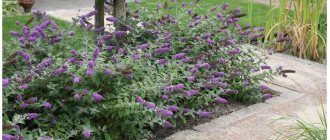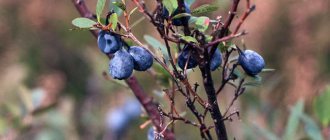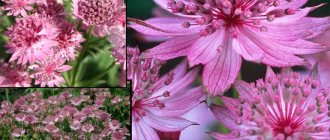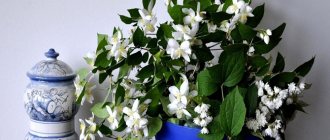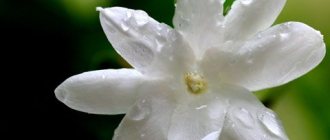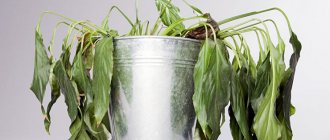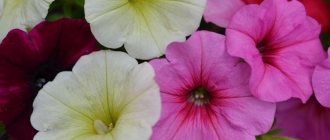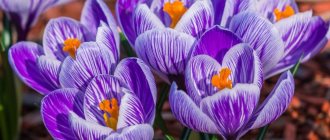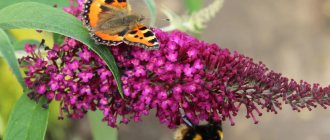Buddleia Davida is a perennial flowering deciduous shrub. The plant is named after the French naturalist David Armand, who discovered this species.
The Buddleya bush is characterized by long flowering, elegant appearance and a delicate honey aroma. If you compare photos of Buddleia and lilac, you will notice the similarity in the shape and shades of the inflorescences. The flowering period of David's Buddel, unlike lilacs, is July-October.
Due to its external similarity and late flowering, Buddleia is often called “autumn lilac.” The Buddhea flower comes in a wide variety of colors: there are cream, crimson, pink, yellow, blue, and purple shades of varying intensities. In southern latitudes, the shrub can grow up to 3 m in height, and in areas with cold winters the plant height rarely exceeds 1.5 m.
In general, this plant is not whimsical, however, planting and caring for Buddleia requires compliance with some nuances.
Brief overview of the article
- Buddleia Davida varieties
- Preparing for landing
- Propagation of Buddleia by cuttings
- Propagation of Buddleia by seeds
- Planting shrubs
- Shrub care after planting
- Fertilizer
- Trimming
- Preparing the plant for winter
- Pest protection
- Diseases of the Buddleia David plant
- Photo by Buddleya Dawaida
Buddleia Davida varieties
About 10 species of Buddleia are suitable for growing in areas with cold winters and for decorative purposes. These include “Ile-De-France” and “Purple Prince” with a lilac tint of inflorescence, bright red “Royal Red”, “Black Knight” with dark purple flowers, pinkish-silver “Pink Delight”, delicate white “White Profuse” "with delicate white inflorescences, "Flower Power" with unusual contrasting blue-orange inflorescences.
Types and varieties
Some species are grown as ornamental plants, but they are often wild. The most common species in temperate climates (Buddleja davidii) is native to China.
Some other types
| Russian name | Latin name |
| Buddleia white-flowered | Buddleja albiflora |
| B. alternate-leaved | B. alternifolia |
| B. asian | B. asiatica |
| B. globular | B. globosa |
| B. japonica | B. japonica |
| B. snowy | B. nivea |
| B. sage | B. salvifolia |
| B. narrow-haired | B. stenostachya |
| B. Collvilla | B. colvilei |
| B. Fallova | B. fallowiana |
| B. Forrest | B. forrestii |
| B. Lindley | B. lindleyana |
In the temperate climate zone, 2 species and one interspecific hybrid are grown as ornamental plants and at the same time winter-hardy:
- species of Buddleja davidii;
- Alternifolia species;
- hybrid – B. × weyerana, whose parents are B. globosa and B. davidii.
Buddleya David
Buddleja davidii has many common names:
- "butterfly bush";
- "summer lilac";
- "orange ear"
The plant's homeland is China (southwestern part), the species has become known in Europe since the 1890s. It easily spreads on its own in abandoned areas, such as quickly taking control of a section of London destroyed during World War II. In some parts of the United States, the cultivation of Buddleia Davida has been banned.
Budleya Davida is a shrub that naturally reaches 5 m in height with a wide, loose crown. The leaves are dark green, shiny, single, transverse, narrow, ovate or elliptical, with dense teeth, pubescent below, 4-20 cm long. Inflorescences up to 30 cm long in nature. The color of the flower crown ranges from purple to dark purple, sometimes white with an orange-yellow throat. The fruit is in the form of a cylindrical bag. The seeds are elliptical, small, with wings at both ends. Blooms from May to October. Flowers produce nectar and a strong, pleasant smell, attracting pollinators - butterflies, bees, hummingbirds.
Due to its large seed production, the buddleia shrub is easily spread by wind and water, and its extensive adaptability has made it a threat to natural forest ecosystems in New Zealand and Australia, as well as parts of the United States and Great Britain.
Withstands a wide range of climatic conditions. Prefers a sunny or slightly shaded position, well-drained and fertile soil with a pH of 5.5-8.5. The shrub is drought tolerant, but sensitive to low temperatures. Remains evergreen in warm climates. Blooms in the first year after planting.
The literature says that the frost resistance of Buddleia Davida is up to -15 degrees. C. Much depends on the local microclimate and the shelter of the site. In any case, the further north the site is, the more reliable the shelter should be and the later its subsequent removal.
Popular varieties
Budleya is very popular, so many color variations of this unique plant have appeared. Varieties differ in color and shades of flowers; they are dark purple, pink, violet, blue, and white. Many varieties may have slight differences in the height of the bushes and the size of the inflorescences.
Many varieties have been bred, the vast majority of them are not winter-hardy and of little use in our climate. Below are varieties that somehow grow in the temperate climate zone.
Commonly grown varieties of Buddleia Davida are:
- "Royal Red" (Budleja Dawid Royal Red) is a vigorous growing variety with interesting, intensely colored flowers. The small flowers have a distinctive scent that attracts butterflies. The variety has low frost resistance; when planted in the Moscow region, care includes mandatory winter shelter.
- “Black Night” is a bush 1.5-2 m high. Dark purple-violet flowers are collected in sparse panicles 30-40 cm long. Incomplete frost resistance.
- “Border Beauty” is a compact bush that grows up to 1.5 m in height per year. The flowers are fragrant, collected in panicles 30 cm long. Incomplete frost resistance.
- “Empire Blue” - the shrub grows up to 1.5-2 m in a year. The flowers are purple-blue with an orange eye, panicles 25-30 cm long. Incomplete frost resistance.
- "Harlequin" is a loose bush, 1.5-2 m high. Leaves have a light edge. Fragrant flowers are purple-red, panicles 20-30 cm long. Frost resistance is average.
- “Ile de France” (Ile de France) - a wide bush due to hanging shoots, 2-2.5 m high. Purple flowers with yellow eyes, very large inflorescences (length reaches 40-60 cm, diameter - 10 cm) . Frost resistance is average.
- “Nano Blue” (Nanho Blue) is a compact bush, grows up to 1-1.5 m. Pleasantly smelling flowers are violet-blue, panicles 20 cm. Incomplete frost resistance.
- “Peace” is a wide bush, 2-2.5 m high. White flowers with an orange eye are collected in panicles (30 cm). Frost resistance is below average.
- “White Profusion” is a bush 1.5-1.8 m high. White flowers are collected in panicles (25-30) cm, but less full and smaller in diameter than the previous variety. The main advantage is resistance to low temperatures.
Almost all varieties begin to bloom in July, with slight differences. The White Profuse variety blooms about a week or 10 days earlier than Ile de France. First, the bushes bloom at the tops of the shoots, the next inflorescences appear from the upper axils of the leaves.
Preparing for landing
A sunny area, securely sheltered from strong winds, is suitable for planting Buddleia. The shrub tolerates sunlight well, but grows slowly and sparingly in the shade.
As for the soil, the most suitable for Buddleya will be loam or sandy loam. The soil must have a neutral PH.
A favorable time for planting shrubs in open ground is spring or mid-autumn.
Propagation of Buddleia by cuttings
Growing Buddleia from cuttings begins in the fall, when it is time to harvest planting material. At the end of flowering, cuttings of at least 15 and no more than 20 cm in length are cut from the plant. In this case, at least 3 growth buds must be present on the workpiece.
Cuttings can be postponed until spring, or transferred to a permanent place immediately after cutting. Young seedlings overwinter in the same conditions as adult shrubs. In spring, when the earth is warmed by the sun and moistened, their active growth begins.
To preserve cuttings until spring, a dark and cool room is suitable. The cuttings must first be placed in damp peat or sand. In the spring, these blanks are transplanted into a greenhouse. Before planting, an oblique cut is made on them and kept in water or a special biostimulant.
When storing cuttings at home, after processing, they are planted in separate containers with moist sand and peat soil, then covered with film to create a greenhouse effect. Rooting cuttings in this way takes up to 2 months.
A plant from a greenhouse is transplanted into open ground in the fall, a “house” plant in the spring.
Buddleia from seeds
Seeds will have to be bought in a specialized store or ordered online. and this is exactly that rare case when you shouldn’t be afraid of imported producers: varieties zoned for Europe are fine here too. You can use your own seeds for planting, if you have them.
Buddleia seeds
Buddleia seeds are very small. They are sown on top of the ground without being incorporated into the soil. To plant, take a container with drainage holes, pour drainage into the bottom, then cover ¾ of the soil. If the seeds are planted on snow, then a thick layer of snow is laid on top of the soil mixture. If planting is done without snow, the seeds are distributed over the surface of the soil and then lightly pressed into the soil. After which the container is covered with glass and placed in a warm, well-lit place, where the temperature is close to +25°C. R
Attention!!!
Crops should not be exposed to direct sunlight.
Buddleia seedlings
Buddleia seedlings will sprout after 10-14 days. When the crops sprout, the glass and film are not removed, but only removed for 20-30 minutes for ventilation. Condensation from glass is killed with a rag. The shelter should be removed when the seedlings become stronger and grow. When 2-3 true leaves appear, make a buddleia pick. It is best to transplant seedlings into peat humus pots. To prevent the appearance of blackleg, seedlings are regularly irrigated with a solution of Fitosporin or a weak solution of potassium permanganate.
Propagation of Buddleia by seeds
Another way to propagate shrubs is to grow Buddleia from seeds. Seeds can be collected from a mature plant or purchased at garden/flower shops.
In the natural environment, the seeds ripen in the fall, but with a lack of sun, some of them will not be suitable for reproduction. On the contrary, under favorable conditions, Buddleia seeds have good germination and germinate quickly, falling into the soil. If you do not follow this process, the bush will grow quickly.
The seeds are used to grow seedlings in February (early spring). After the seedlings have grown stronger, they are planted in prepared heated soil. In this case, planting time is at the end of spring.
Application in the garden
As a rule, these are single large shrubs, which from mid-summer become the main attraction of the garden. Buddleia also forms untrimmed tall hedges, serving, for example, to cover an unsightly wall of a neighbor's shed, or as a large element of garden design along with other previously flowering shrubs.
Plants that bloom in summer will be good neighbors for buddleia:
- sage,
- karyopteris cladonian,
- aster,
- lefty,
- lavender.
Dwarf varieties of buddleia can be planted along paths, in large containers.
When grown in containers, you will have to put up with a significant reduction in the flower panicle.
You can cut flowering shoots and place them in a vase. The inflorescences are cut off when half the flowers appear, then they will be fresh in the vase for about a week.
Planting shrubs
Planting Buddleia in open ground begins with preparing a planting hole with a width and depth of 40 to 50 cm (the size of the root system + 20 cm). The distance between adjacent bushes should be equal to the width of an adult plant.
A drainage layer is made at the bottom of the planting hole, then fertilizer is added, the seedling is placed, covered with the required amount of soil and compacted. Next, the seedling is watered abundantly, and the surface around is covered with mulch (compost).
Landing and seat selection
Buddleia is a light-loving plant, so for its growth and development it is necessary to choose a sunny place, protected from gusty winds.
Before planting a seedling, you must first prepare a 40x40 seat . At the bottom of the pit, drainage is laid in a layer of 15 cm and a small layer of nutritious soil mixed with humus and mineral fertilizers is poured. A bush is placed in the prepared area and covered with soil so that there is no air cushion left.
The soil around the plant is compacted, thoroughly watered and mulched. When planted correctly, the root collar should not be too deep into the ground.
If more than one plant is being planted, they are planted at a distance of 2 meters from each other.
Shrub care after planting
After being transferred to open ground, Buddleia seedlings must be watered regularly. The frequency of watering is determined by the frequency of drying of the top layer of soil. For an adult plant, irrigation during dry periods is also important. Irrigation is carried out in the early morning or evening, when solar activity decreases.
It is also necessary to loosen the soil so that the roots breathe and receive the substances necessary for life. When loosening, you need to take into account that the plant has a horizontal root system.
Aftercare
The agricultural technology of the Buddleia Davida Black Knight variety includes watering young shrubs up to 2 years of growth once a week, provided there is no precipitation. For an adult plant, 1 time per month is sufficient. The bush needs sprinkling every evening, regardless of the growing season.
Loosen the soil as the weeds grow and the top layer of soil dries out. Young bushes of Buddleia Davida Black Knight are fertilized at the root in the spring; superphosphate fertilizer “Kemira Universal” is suitable.
To preserve the decorative appearance of the shrub, the variety requires cosmetic pruning during flowering. Faded flower stalks are removed and new ones are formed in their place. In the spring, old shoots and dry fragments are pruned, and the bush is thinned out. Trim the length and, if necessary, reduce the width of the bush. Formative cutting of buddleias of this variety is carried out at will.
In autumn, the root circle is mulched with dry sawdust, leaves or straw. In spring, the layer is replaced with peat mixed with straw or pine needles.
Preparing for winter
Young seedlings of Buddleia Davida Black Knight need crown cover; a cap is made of polyethylene stretched over arcs on top, covered with spruce branches or dry leaves, and covered with snow in winter. Mulching is indicated for adult buddleia and annual ones. For the Buddleia variety Davida Black Knight, after two years of growing season, the roots are spudded, covered with a layer of mulch (15 cm), and the trunks are wrapped in fabric.
The main task is to preserve the root system of buddleia. If the winter has low temperatures and minimal snow, the shoots will freeze, they are pruned in the spring, the variety quickly produces young shoots, and flowers form on new stems.
Disease and pest control
Buddleia Davida is not affected by infection; if waterlogging causes rotting, the variety is treated with an antibacterial agent. The drug “Actellik” and the destruction of a nearby colony of ants will help in the fight against aphids. Whitefly moth caterpillars are eliminated using the contact agent “Keltan”; buddleia treatment is carried out in sunny weather.
Fertilizer
Buddleia can and should be fertilized several times a season. The first feeding is done after winter, during the appearance of buds. This requires fertilizers with a high nitrogen content.
The next feeding is carried out in the summer, when the flowering season begins. During this period, the plant needs phosphorus and potassium - they stimulate flowering and growth. In the remaining time, you can use organic fertilizers - humus, compost slurry, ash.
Trimming
A necessary procedure in caring for Buddleia is pruning. In its absence, the shrub loses its attractiveness due to bare branches, and the intensity of flowering decreases. Pruning helps give the shrub a neat appearance. As a rule, this pruning procedure is carried out in the spring.
The year following planting, young branches are cut to 50% of their existing length. In the second year after planting, it is necessary to trim off weak branches and new shoots that extend beyond the overall dimensions of the shrub.
Young shoots are cut off by 50% or more, and old shoots are completely removed. This pruning is repeated in subsequent years.
History of selection
The new type of ornamental shrub was noticed by the wandering missionary and naturalist monk David. The plant, native to China, has not previously been described in any botanical reference book. The monk sent a herbarium version to England to the researcher of new specimens, biologist Rene Franchet. The scientist made a complete description of the plant and gave it a name in honor of the rector of the university in the town of Essex (England) Adam Buddle, a botanist of the 8th century.
Nowadays, buddleia bears a double name in honor of the discoverer and outstanding researcher in the field of biology. Subsequently, selection work was carried out, on the basis of a wild crop, new species were obtained, adapted to the weather conditions of Europe and then Russia. The Buddleia variety Davida Black Knight is one of the relatively frost-resistant representatives of the species grown in the Russian Federation.
Preparing the plant for winter
Buddleia Davida is a heat-loving plant, so in cold winters with lots of snow and frost, it will need shelter. Under protection, buddleia tolerates frosts down to -20 degrees C. To preserve an adult plant during the winter season, it is covered with breathable material, for example, burlap.
You can install a massive box as a holding frame, taking care that strong winds do not break the covering structure. Any film is not suitable as insulation, because... roots and branches may interfere.
Botanical description
Buddleja (Buddleja L.) is a genus of plants belonging to the Norichaceae family, numbering about 140 species. Sometimes the plant is mistakenly called Budleya, but it is correctly spelled with two “ds” after the name of the British botanist Adam Buddle. They are generally fairly tall shrubs, although there are a few species that grow in tree form. The highest species reaches 30 meters.
Buddleias are found on both American continents, East Asia, and southern Africa. They most often grow in rocky areas, on slopes and cliffs, often at the edges of forests. Many species are among butterflies' favorite nectar sources, but are also pollinated by other insects and hummingbirds.
Morphology:
- Fast-growing shrubs, less often small trees, vines, woody perennials at the base.
- The shoots are covered with star-shaped, thyroid or glandular hairs.
- The leaves are opposite, sometimes alternating. Most species lose their leaves in the winter or dry season, and some are evergreen (in the tropics) or partially evergreen. The petioles are usually short. The leaf blade is often elongated to lanceolate. The edge of the leaf blade is rounded or jagged.
- The flowers are fragrant, small, the largest of the Colville budlei species reach a diameter of 2.5 cm. The flowers are collected on the tops of the current year's shoots in dense, grape-like (narrow) panicles or heads, rarely in bunches on last year's shoots. Cup-shaped or conical shape. The flower crown consists of four petals fused into a tube, sometimes curved. The petals are rounded at the ends, white, yellow, orange, pink, purple. Stamens – 4 pcs. The length of the inflorescence is 20-40 cm, rarely up to 60 cm.
- The fruits are two-valved sacs with numerous small seeds, often winged. Rare fruits are berries (in the species Buddleja madagascariensis).
There are varieties with tricolor flowers.
Pest protection
In dry, arid weather, the plant can be attacked by aphids and whiteflies, which feed on Buddleia sap. Insecticides help control these pests.
Spider mites can also appear on the leaves and inflorescences of Buddleia, under the influence of which the tissues gradually die. Acaricides - chemical/biological preparations of contact action - will help to cope with this pest.
Diseases and pests
Buddleia has strong immunity to many diseases. The main enemies of the shrub in dry summers are spider mites and whiteflies. Treatment consists of timely removal of damaged branches and spraying the plant with insecticides.
This plant is an ideal option for decorating a summer cottage . Thanks to its bright inflorescences with a charming aroma, it attracts butterflies, which, fluttering over the bush, give an unforgettable atmosphere of comfort and joy. With proper and timely care, buddleia will decorate any corner of the garden for many years.
Diseases of the Buddleia David plant
Buddleia Davida is a plant that rarely gets sick. This quality can be considered one of its advantages. However, if there are prolonged rains in the summer, gray rot may develop on the leaves and branches, which grows, spoils the appearance and can even lead to the death of the bush. Excessive watering of the plant will lead to the same result.
If the problem is noticed in time, the affected areas are removed and the plant is treated with a fungicidal (antifungal) drug. With proper care and timely treatment, the Buddleia shrub will have an attractive appearance and delight with long flowering.
In garden design
Spreading branches, lacy green foliage, a fountain of multi-colored inflorescences decorating the garden at a time when other ornamental shrubs have already faded, make buddleia the dream of any landscape designer. The plant is decorative already in the spring, when leaves appear that have an interesting color: the upper side of the leaf blade has a deep dark green color, and the lower side has a gray-velvety tint.
The bush is beautiful both in single and group plantings, and it looks appropriate regardless of the size of the summer cottage and fits harmoniously into any landscape compositions and landscape corners. Spectacular combinations of varieties with inflorescences of different shades look extraordinary. On clubs and mixborders, buddleias are harmoniously combined in habit and color with other perennials, for example, with hydrangeas and roses, with conifers and cereal grasses. Under the luxurious crown, you can plant any shade-tolerant plants - hosta, kupena, periwinkle.
Buddleia Davida can be used to create beautiful hedges, borders and be used for zoning areas. In addition, shrubs are grown as standard trees and as tub crops, decorating terraces and balconies with them.
